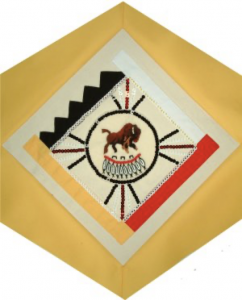Peigan

The Block
Mae Smith combined her talent for beadwork, with her sister, Florence Pilling’s sewing and quilting skills, to create the Peigan block. Their design was inspired by a 19th-century Yellow Sun tepee owned by their ninety-four year old father. It is worked in the traditional four colours of man (black, white, red and yellow), which also symbolize the cardinal points of a compass and the ever-changing seasons. An embroidered buffalo conveys the importance of these massive beasts as a primary food source for the Peigan, while the Rocky Mountains represent their homeland on the plains of Alberta.
Cultural Profile
Commonly known as “Peigan,” alternative spellings for this First Nation include Pe-kun-nee,Pikuni, Pakuni and Piikani (which literally translated means “poor robe”). The Peigan, traditionally a nomadic society, belong to the Algonquin language group and were the last of the woodland Algonquian tribes to migrate to the western provinces, where they lived in buffalo-skin tepees. Closely related to the Bloods (Kainai) and the Blackfoot (Siksika or Niisitapiikwan), they were the largest of the original tribes (along with their U.S. brothers in Montana) to form the Blackfoot Confederacy.
The Sun Dance was the Peigans most important religious ceremony, as Napiw (the sun deity) was often called upon for supernatural aid. Based on age, the men of the tribe were organized into a series of warrior societies whose main function was to protect the camp from invaders, and to preserve order in camp and on hunts. Men and women traditionally wore deer-skin clothing decorated with porcupine quills and beads, which were often made with silverberry seeds.
When the Peigan signed Treaty 7, they asked for, and received, “the Oldman River, the Porcupine Hills, and Crow Creeks” because these were the favoured wintering areas that provided a good base to hunt buffalo. When they settled on the reserves in 1879, they were encouraged to take up agriculture, which was soon supplanted by cattle ranching, a practice that continues today.
Approximately 2,800 North Peigan Pikuni are located in Alberta (an alternate source cites only 1,537 in 2001). The Peigan tribes were the first to assume administration of their own reserve and to demand a vote in provincial elections. They also introduced, and still host, Indian Day Celebrations to maintain and promote their culture.
Sponsor: Walter & Mary Cartwright, in memoriam Dorothy and Bernard Broadhead
